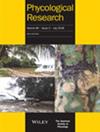Taxonomic revisions based on genetic analysis of type specimens of Ulva conglobata, U. laetevirens, U. pertusa and U. spathulata (Ulvales, Chlorophyta)
IF 1
4区 生物学
Q2 MARINE & FRESHWATER BIOLOGY
引用次数: 16
Abstract
Genetic analysis of type material of various Ulva species has shown that many names have been misapplied. DNA sequences of two of the specimens on the lectotype sheet of U. australis from South Australia showed that U. australis is conspecific with specimens called U. pertusa from Japan. However, type material of U. pertusa has not been sequenced, nor have other type specimens with type localities in Japan and Australia, including U. conglobata f. conglobata and U. conglobata f. densa from the former, and U. laetevirens and U. spathulata from the latter. To determine if these names have been correctly applied, targeted DNA sequencing of the rbcL gene was performed on (i) the lectotype specimen of U. laetevirens, (ii) the lectotype and two syntype specimens of U. pertusa, (iii) the lectotype and two syntype specimens of U. congoblata f. conglobata and (iv) two specimens on the holotype sheet of U. conglobata f. densa. In addition, high‐throughput sequencing (HTS) analysis was carried out on an isotype specimen of U. spathulata. Phylogenetic analysis of the resulting rbcL gene sequences supports the taxonomic conclusions that U. laetevirens, U. pertusa and U. spathulata are synonyms of U. australis, and U. conglobata f. conglobata and U. conglobata f. densa represent a single separate and distinct species, U. conglobata. These genetic data contribute to the taxonomy of Ulva and further demonstrate that analyzing DNA from type material is the only currently known reliable method to correctly apply names in this genus.基于遗传分析的石首乌、扁叶石首乌和匙形石首乌(Ulvales,Chlorophyta)模式标本分类订正
对不同Ulva种类型材料的遗传分析表明,许多名称被误用。来自南澳大利亚的南澳大利亚U.australis的选择模式表上的两个标本的DNA序列表明,南澳大利亚U.australiss与来自日本的名为U.pertusa的标本是同种的。然而,pertusa的模式物质尚未测序,在日本和澳大利亚也没有其他具有模式位置的模式标本,包括来自前者的C.conglobataF.conglobata和C.conglopataF.densa,以及来自后者的U.laetevirens和U.spatulata。为了确定这些名称是否被正确应用,对(i)乳杆菌的选择型标本,(ii)pertusa的选择型和两个同型标本。此外,还对匙形藻的同型标本进行了高通量测序(HTS)分析。对由此产生的rbcL基因序列的系统发育分析支持了分类学结论,即扁病毒U.laetevirens、pertusa和匙形藻U.spatulata是澳大利亚扁病毒的同义词,而伴圆菌U.conlobata f.伴圆菌和伴圆菌U.densa代表一个单独和独特的物种,伴圆菌。这些遗传数据有助于Ulva的分类学,并进一步证明从类型材料中分析DNA是目前已知的唯一可靠的方法,可以正确地将名称应用于该属。
本文章由计算机程序翻译,如有差异,请以英文原文为准。
求助全文
约1分钟内获得全文
求助全文
来源期刊

Phycological Research
生物-海洋与淡水生物学
CiteScore
3.60
自引率
13.30%
发文量
33
审稿时长
>12 weeks
期刊介绍:
Phycological Research is published by the Japanese Society of Phycology and complements the Japanese Journal of Phycology. The Journal publishes international, basic or applied, peer-reviewed research dealing with all aspects of phycology including ecology, taxonomy and phylogeny, evolution, genetics, molecular biology, biochemistry, cell biology, morphology, physiology, new techniques to facilitate the international exchange of results. All articles are peer-reviewed by at least two researchers expert in the filed of the submitted paper. Phycological Research has been credited by the International Association for Plant Taxonomy for the purpose of registration of new non-vascular plant names (including fossils).
 求助内容:
求助内容: 应助结果提醒方式:
应助结果提醒方式:


